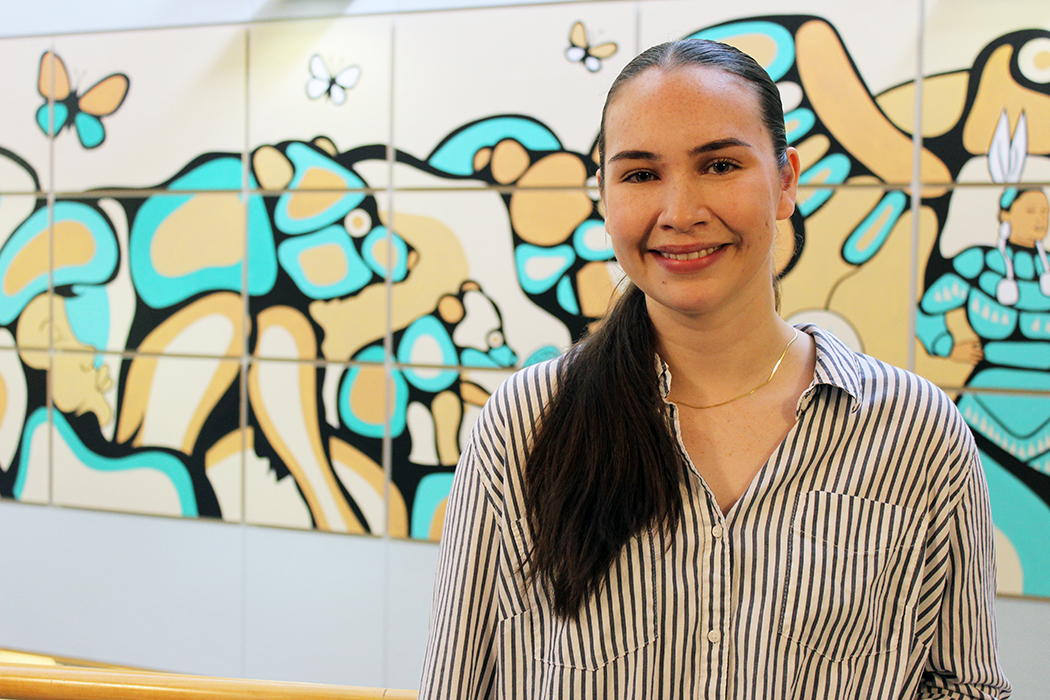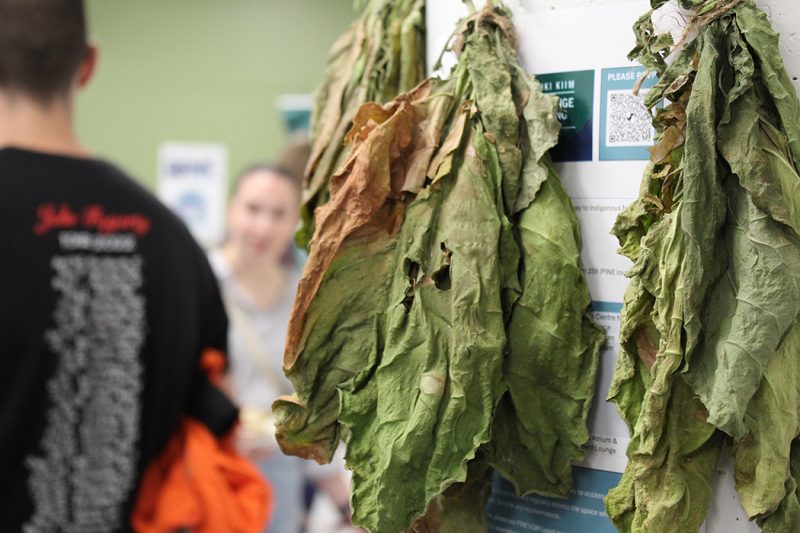
Nursing student Justice Spence in front of the new mural at the Helen Glass Centre for Nursing. She said the new PINE lounge will be a safe, comfortable space for Indigenous nursing students.
New student lounge, mural bring ‘sense of belonging’ to Indigenous nursing students
On Sept. 18, the College of Nursing held a grand opening celebration for a new lounge for students in its Mahkwa Omushki Kiim: Pathway to Indigenous Nursing Education (PINE) initiative.
PINE offers academic, personal and cultural support to help First Nations, Métis and Inuit students prepare for and succeed in the bachelor of nursing program. The 900-square-foot lounge gives Indigenous students a space of their own to study, socialize and relax.
Just outside the lounge, there is a medicine garden where, earlier this year, PINE staff and students planted seven sage plants, 21 tobacco plants, two cedar bushes, a strawberry bush and one wild mint and rhubarb bush. All the plants and medicines will be for PINE student use.
Lauressa Garson, PINE coordinator and education coach, said the garden will be expanded next year to include a full vegetable and fruit garden and more medicines.
“This will allow PINE to have more food sustainability for our students, as many still face food insecurity. It can be a source for all PINE students both pre-nursing and nursing alike to more food sustainability,” Garson said.
“Students have taken pride in watching the fruits of their volunteerism in helping to plant, weed and learn about the medicines.”
Garson, who calls Tataskweyak Cree Nation home, is a UM bachelor of nursing grad from 2019. She said the space is now properly ventilated for smudging.
“As smudging can be very personal and students may want to do so alone, we want to offer them the ability to do so whenever they need,” she said.
“As a student that only had one place to go, I can understand what it means for students to have full-time access to cultural strengths and supports, as some may not have access otherwise.”

Tobacco leaves harvested from the PINE medicine garden hang in the student lounge.
Justice Spence, who recently completed her senior practicum in emergency at Thompson General Hospital, said the space is a welcome addition for Indigenous students.
“This lounge is really valuable because, honestly, it’s hard to be an Indigenous student in a Western institution. I feel like I struggled with it throughout my whole university experience,” Spence said. “This is somewhere I can feel safe and comfortable, compared to any of the other lounges in the building. I can just be who I am because everyone else understands what I’m going through in that space.”
Prior to a ribbon cutting, a ceremony was held in the Helen Glass Centre for Nursing atrium, where a new mural by Anishinaabe artist Blake Angeconeb was also celebrated.
Angeconeb is a Winnipeg artist who is a member of Lac Seul First Nation in Ontario. He also created a beautiful mural at the Brodie Centre atrium at Bannatyne campus. The mural at Helen Glass is based on the themes of caring, healing and transformation in one’s nursing journey. It also includes imagery of bears, which ties back to PINE, as part of the name, Mahkwa omushki kiim, means “bear medicine” when translated from Ojibway.
College of Nursing dean Dr. Netha Dyck said Angeconeb created the stunning 52-foot mural over a two-week span, painting directly onto wood panels affixed on the atrium’s east wall.
“It was amazing to see him work,” Dyck said. “This new Indigenous art mural is a beautiful addition to our atrium, enriching our space with warmth, familiarity and a strong sense of belonging for Indigenous students.”
Brenda Longclaws, Knowledge Keeper at the College of Nursing, said the mural serves as a powerful symbol of cultural awareness and reconciliation.
“It really adds to the beauty of the college, but I think the significance lies in the fact that it is a piece of Indigenous artwork, and we need to start having more of that reflected at the University of Manitoba.”






